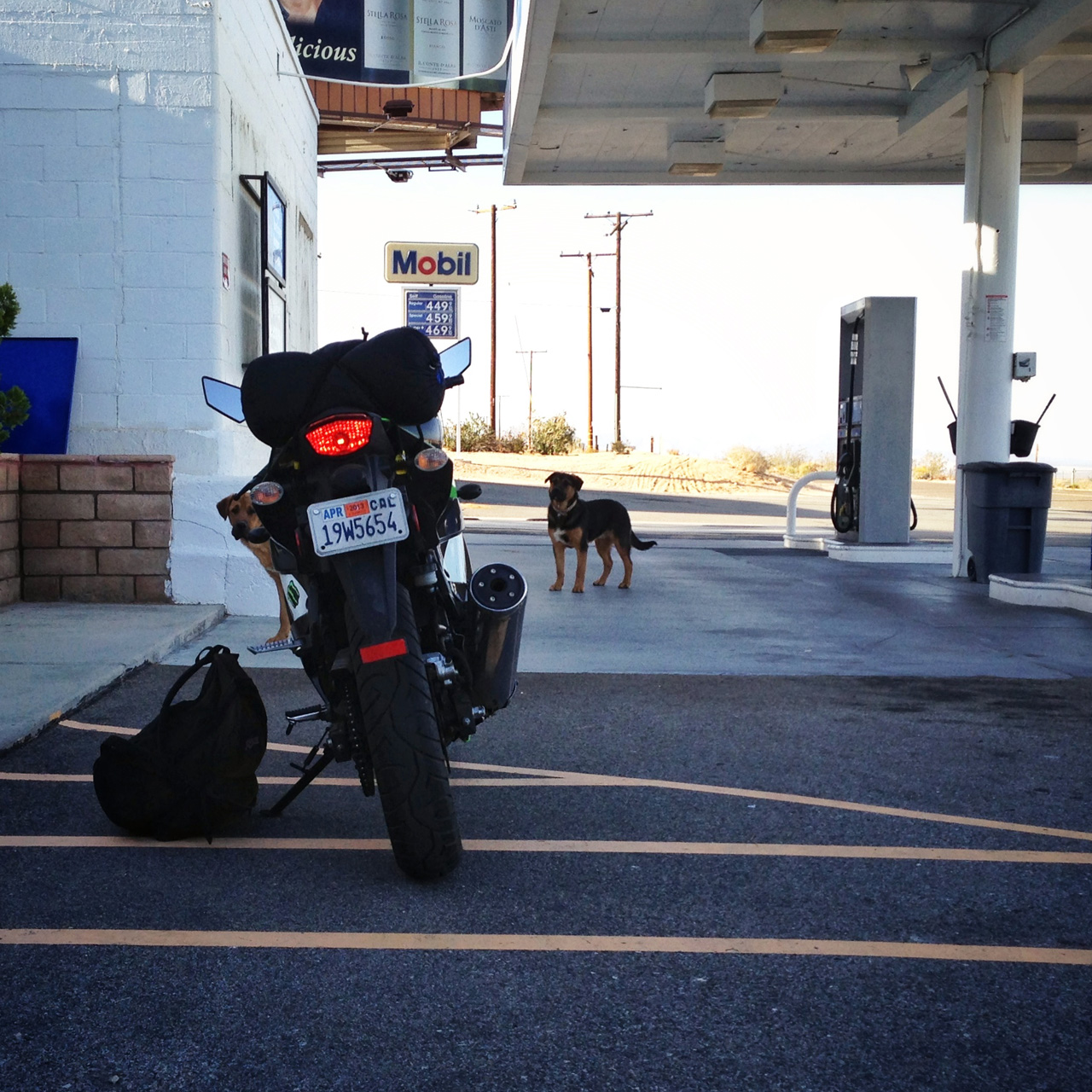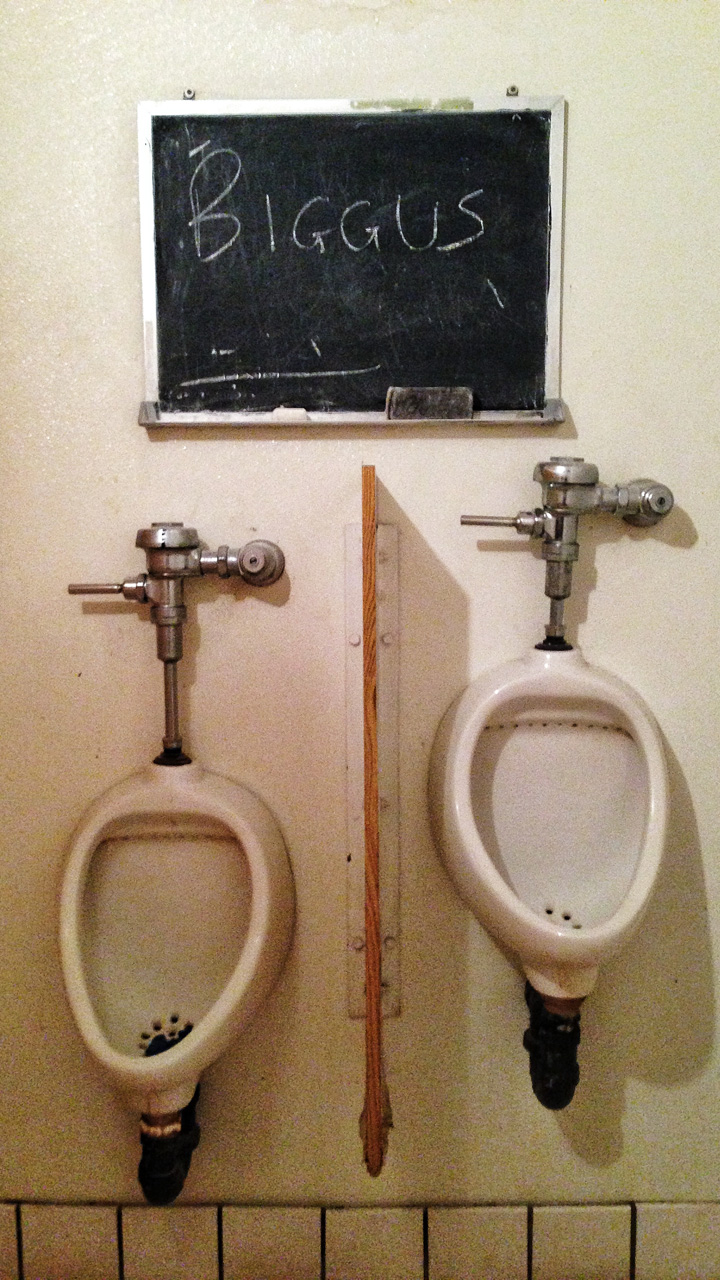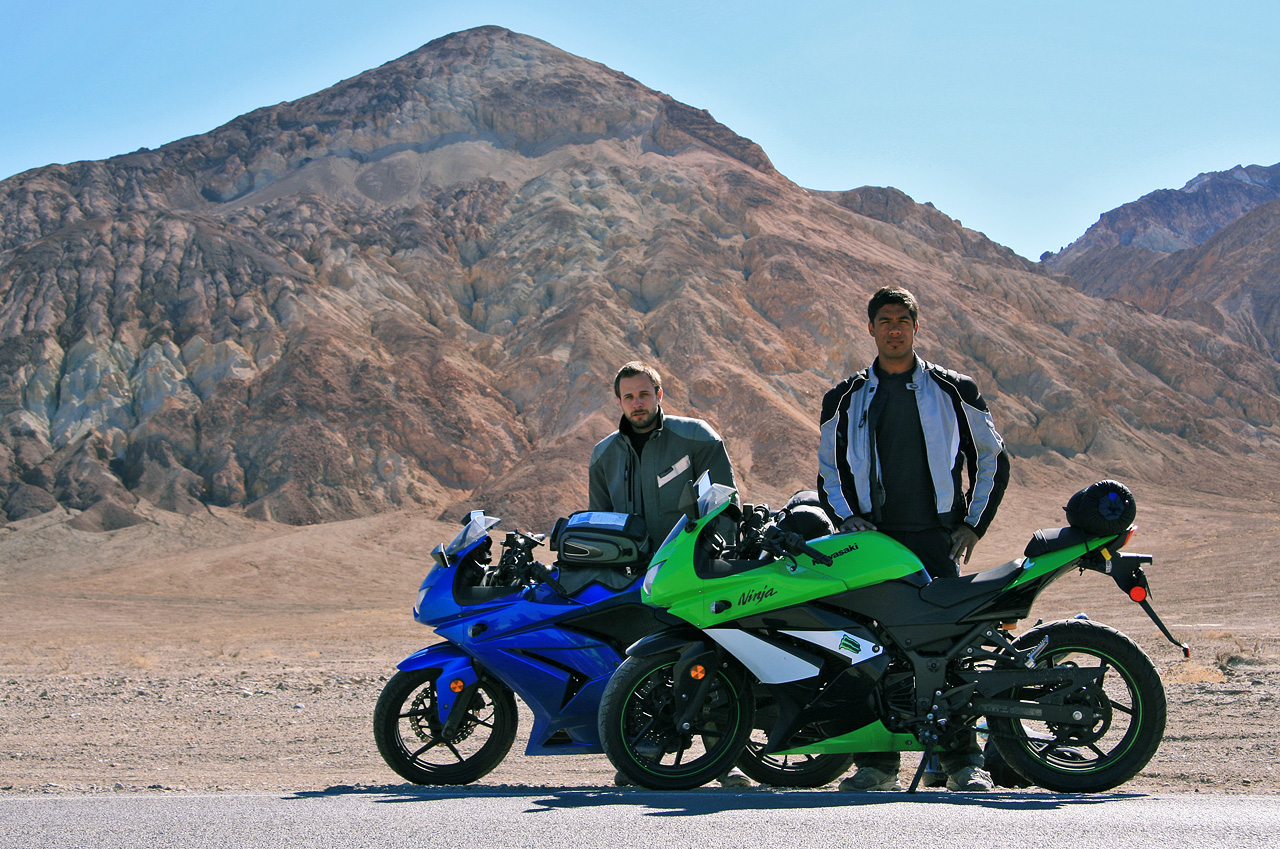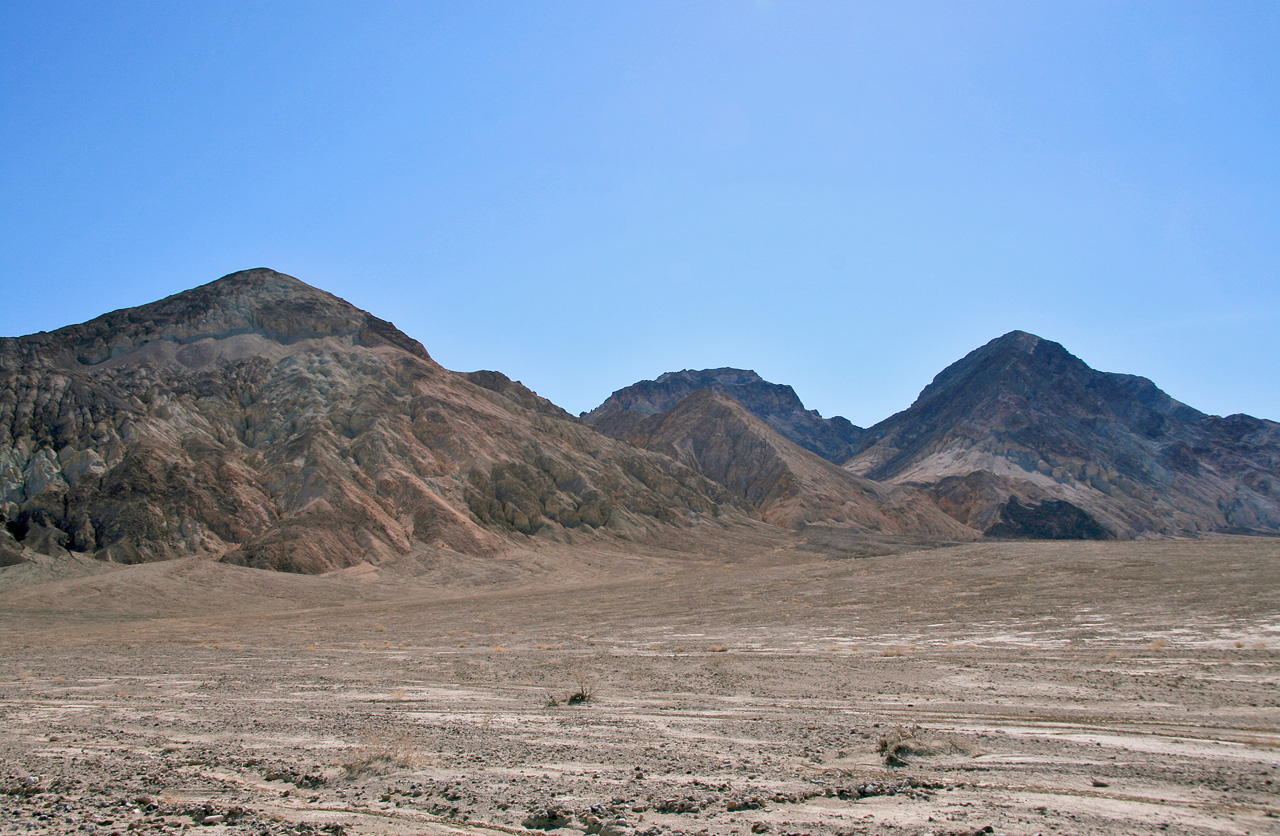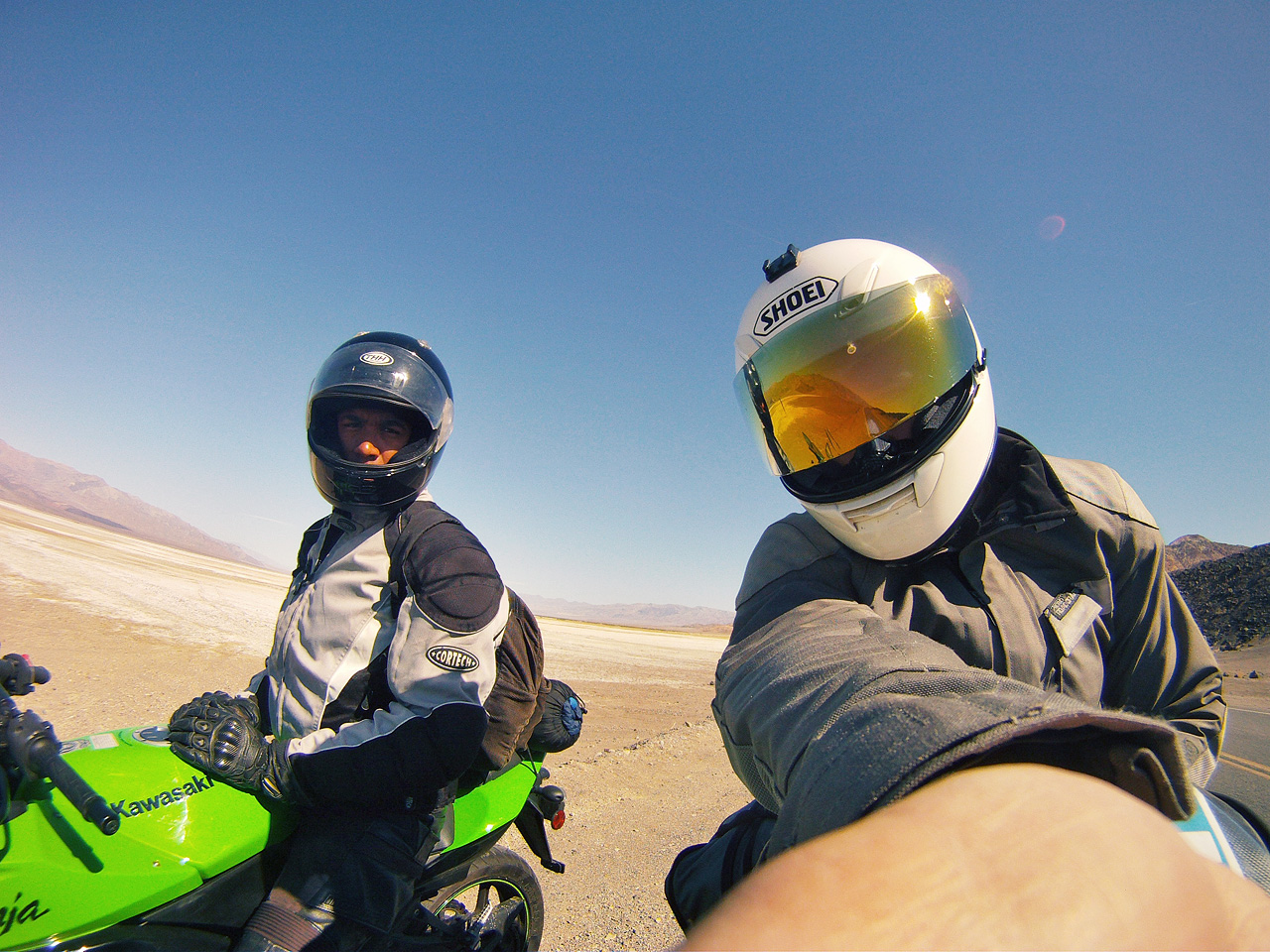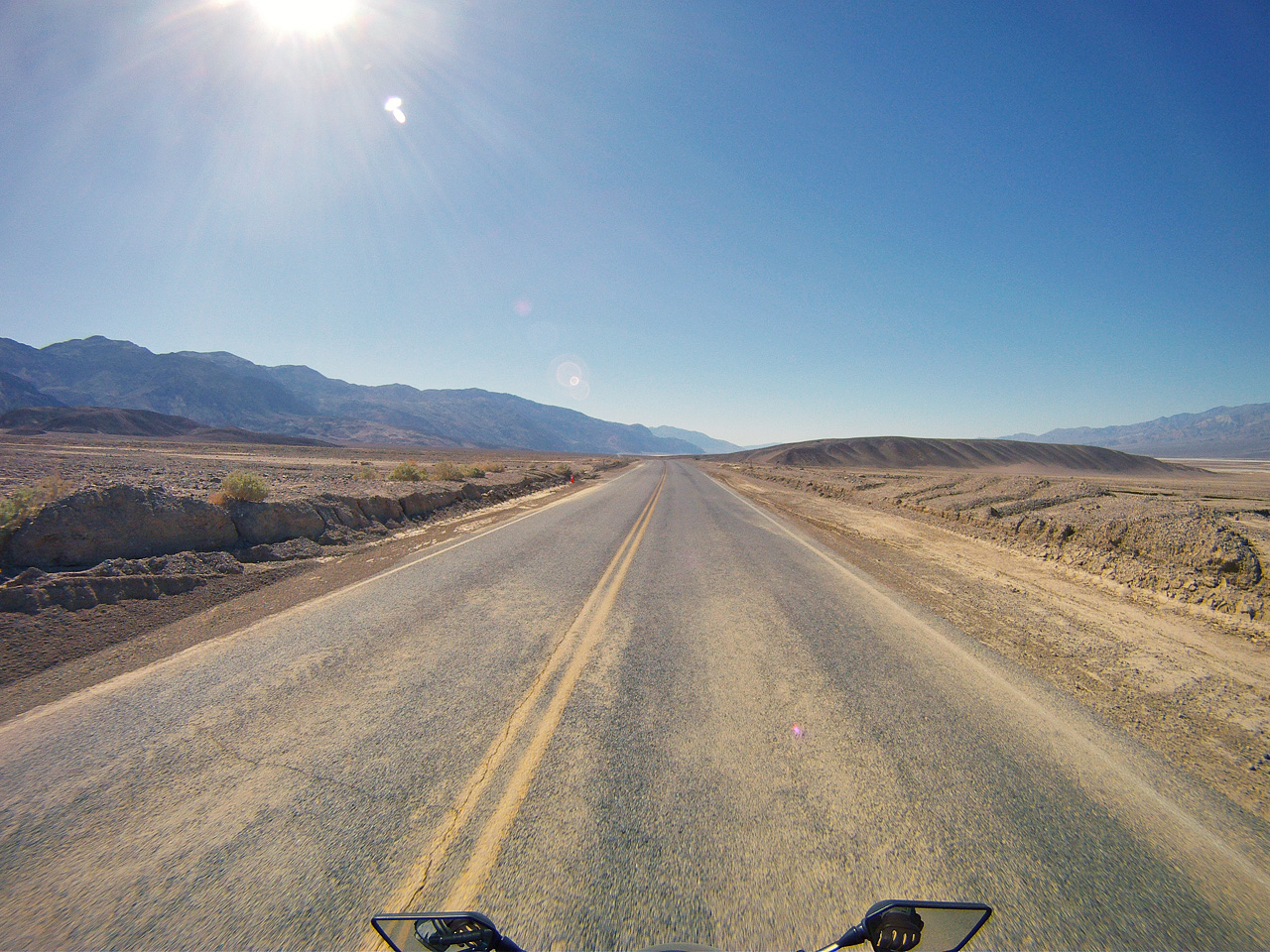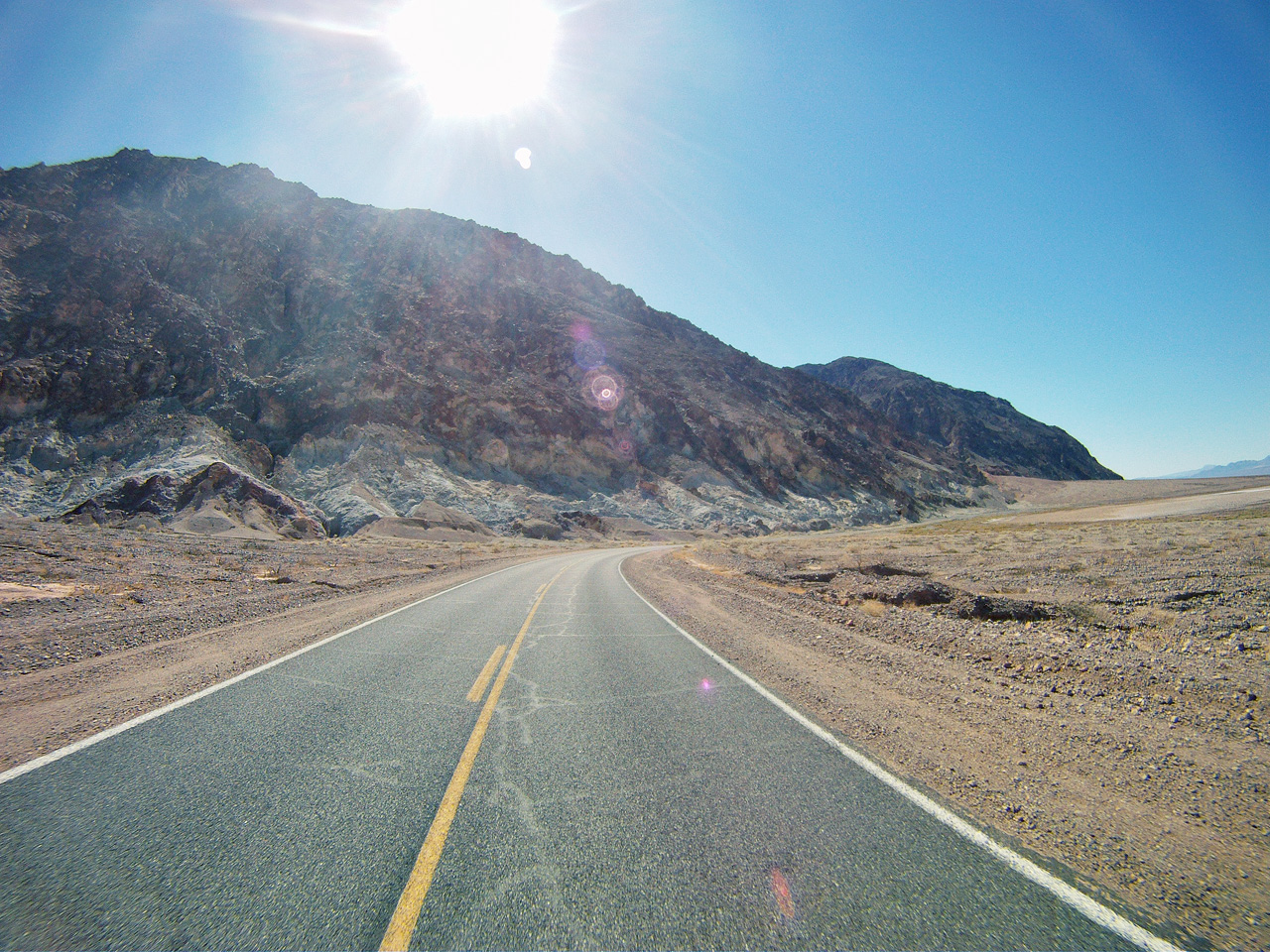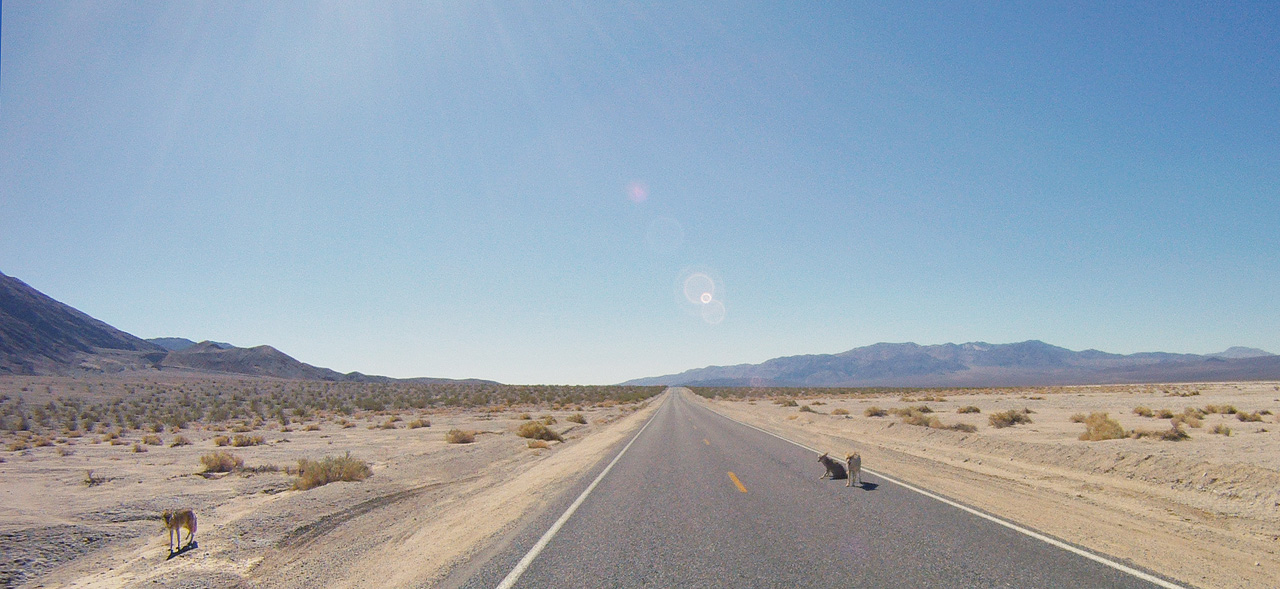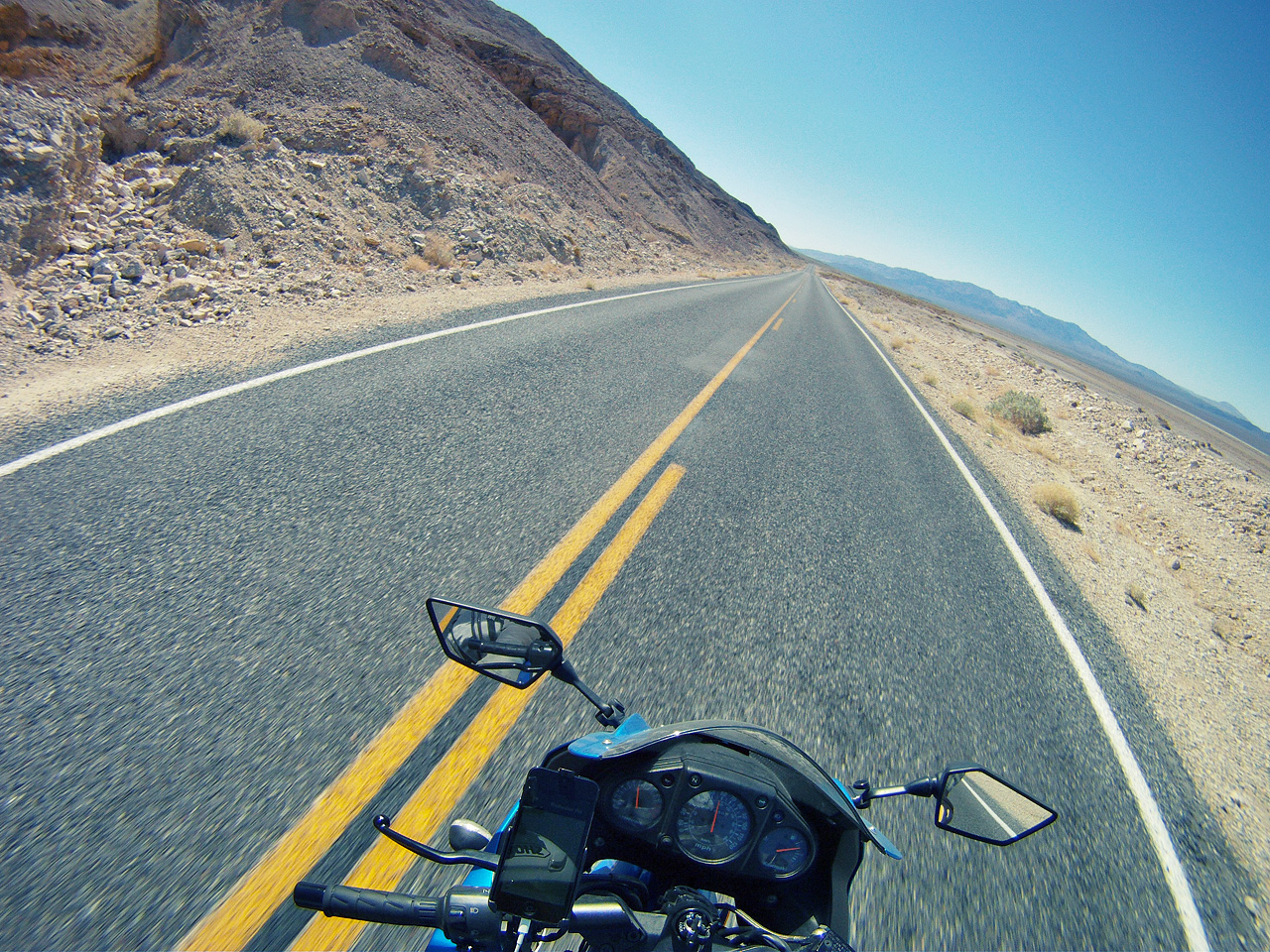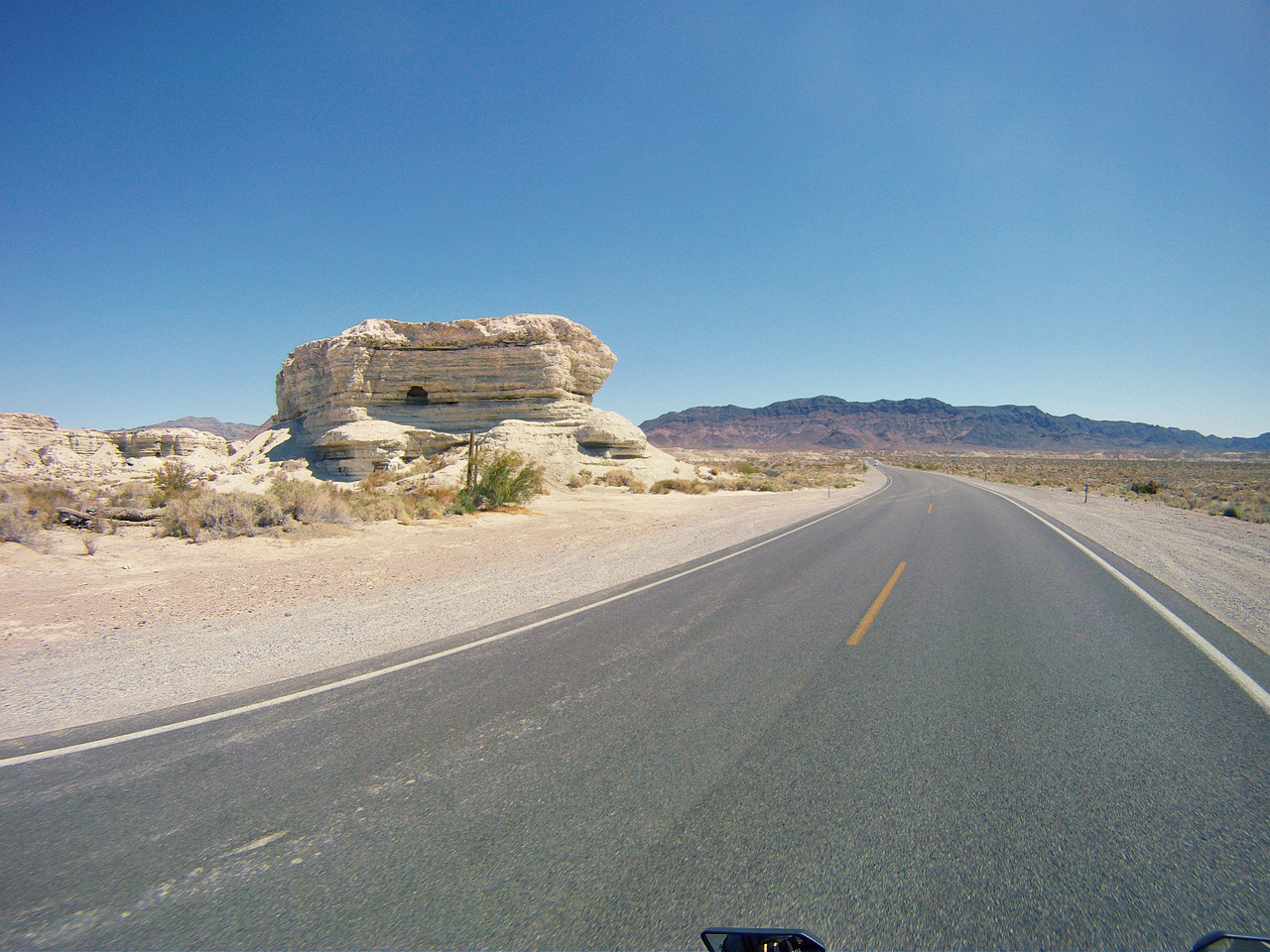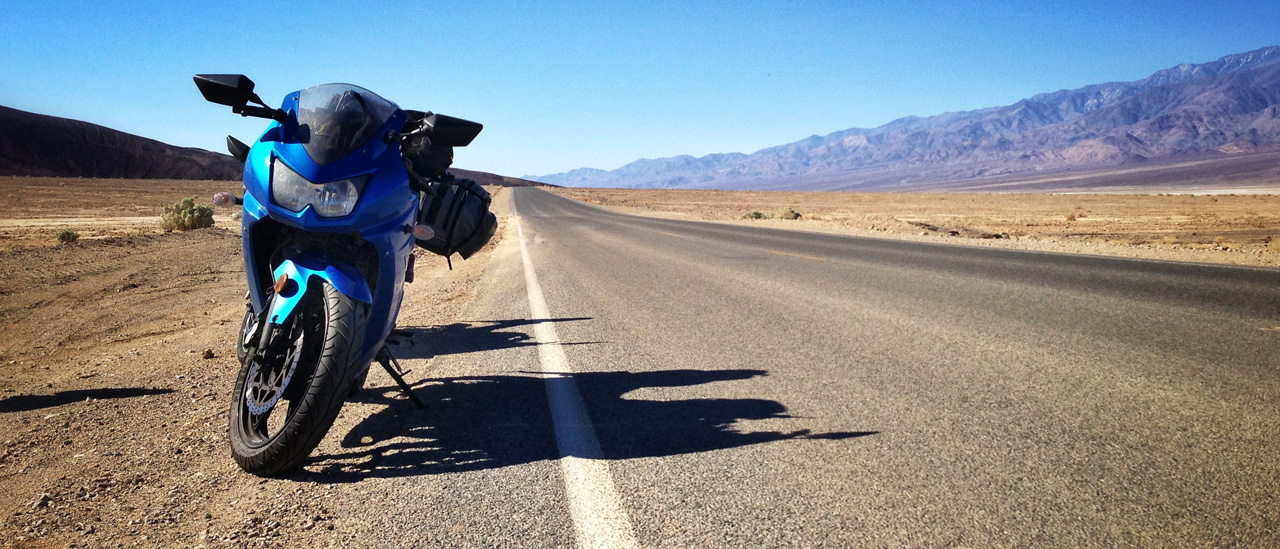Brian’s phone indicated a morning temperature of 27 Fahrenheit in Yosemite Valley. We escaped the park early and by Oakhurst Brian could feel his feet again.
April 9, 2013
Warmliness is godliness. Or maybe the reverse. Copious signage along the highway celebrated a dude named Christ, and one billboard claimed, “Jesus recycles lives.” That’s one way to convince red country to separate their rubbish.
The squiggly blue plan I’d made for the day seemed a bit unnecessary as we ate lunch in Fresno and studied our mobile phones. I’d originally thought to aim for some interesting spot between Yosemite and Death Valley, but there’s not much. And according to Google, we were just six-odd hours from Death Valley anyway. Let’s just go for it? Brian agreed, because even by then he’d not realized I didn’t know what I was doing.
It was ambitious, Yosemite to Death Valley in one day on little bikes with the most convenient route, Tioga Pass, blocked by winter’s leftovers.
It meant head-down sprinting through California’s Central Valley. There’s probably lots to love about living in the Central Valley — there’s probably something to love — but I’ve never experienced any of it. Central Valley to me is miserable heat and straight highways laid with a bias for the state’s shipping industry. I wanted out. So did the squirrel that threw himself in front of our bikes at 70 mph. (The squirrel is fine.)
After two hours of collecting bugs on my visor and wishing I were somewhere else, we finally turned eastward, upward, and away from the valley, riding Highway 58 toward Mojave. A hustling wind farm army at Tehachapi Pass foreshadowed an even worse time. I hardly noticed. My mind was bothered by the clock, which kept ticking faster than Brian and I progressed.
For the first time all day, I saw striking photographs in need of a shutter. Red Rock Canyon was a lovely surprise, eggshell-colored hills broken by red-layered buttes protruding just 30-50 feet above the sand. I thought to stop and snap the shots, but the clock seemed a bigger problem than not having photographs. I desperately wanted a photo in front of the kitschy faux ghost town “Robber’s Roost,” but time shooed us past. As did the wind.
U.S. Route 395 turned us due north, ushered us through the high desert on the back side of the Sequoia National Forest. We were peeking behind the curtains of California’s adventurous mountain scenes to find a barren backstage without humans or trees or really any defining features but the wind curling up and over the mountain tops to the west and tumbling east across the desert.
Brutal wind. The saddle bags on my bike caught the blast like a sail, which may have helped were we heading east. We weren’t yet. Miles of endless space separated cross roads. A sign for an upcoming turnoff gave hope of a gas stop, but more often merely signaled a perpendicular dirt path that pointed to the middle of the desert. Follow one and we might have found Barker Ranch, the rock under which Charles Manson hid from authorities after his family’s filthy foul play.
It was almost six o’clock when we made our last gas stop for the day. Camping in Death Valley was out of the question — we’d never make it before sunset — so I resigned to calling in a hotel reservation. Still the wind roared, and I huddled near the side of the gas station to do my best to block my iPhone from the howling. The wind hadn’t let up in hours and was wearing oppressive. I just wanted respite, but the eerie gas station innards spooked me back outside. Brian remained nonchalant, I couldn’t tell if the rough miles bothered him. I felt guilty for leading him out there, felt guilty for not knowing when where or how we’d get to sleep. My late call to Death Valley hotels returned just one available room. I am embarrassed to admit what it cost, but the alternative seemed unthinkably bleak and probably dangerous.
Brian dropped an ear plug in his gas tank. I pulled out my bike’s toolkit to try and ply the foam thing out. Two stray dogs stood 20 feet from us and barked incessantly, inching forward every time I turned away, slinking back heads-down and barking more loudly whenever I dared step toward them. And still the wind roared.
Miserable shit. This was a bad idea.
The sun had snuck low, hovering just above the western mountain tops, by the time we rolled onto Highway 190 and turned east into Death Valley. Sand flowed like ribbons in the wind, carried across the surface of the road in sheets so thick I could barely make out the asphalt. I snapped shut the vents of my helmet and tucked my chin into the collar of my Aerostich, but sand still scratched at my eyes.
We diced a stellar series of turns up and over the Inyo Mountains. On the other side, a descent to the surface of Mars. We come from Earth, I thought aloud.
Highway 190 winds down the mountain, each sweeping turn presenting breathtaking panoramic views of the valley below. Quite the showman, that highway. The low light bathed the scene in bluish tint on top of red planet. A sci-fi scene with Brian and me at the center, racing the setting sun.
The sun dipped halfway behind the mountains far to the west, reducing my rear view to a glowing horizon on top of tall shadow and Brian’s piercing high beam. Forward visibility was hardly better. The highway was unlit, my helmet visor was layered in dust, and there was little to reflect back my headlight, just a thin strip of black road and a receding sandy shoulder.
The hotel lights mercifully broke the darkness just before 9:00 pm. Two hotel staff members awaited us at check-in and hustled us to the dinner menu before the kitchen closed, before we’d even brought our bags to our room. The staff seemed genuinely relieved to get us off that highway — Brian and I were the last guests to arrive — and even offered a Jeep ride to a nearby general store when the hotel menu seemed too stuffy. I slept well.
April 10, 2013
Blinding sunlight watered my eyes as we stepped out of the hotel room. The previous night’s wind had subsided, the sky was pristine blue. Death Valley made a friendlier impression in the morning.
Brian and I retrieved our bikes from the lower lot to pack them closer to our room. The valley was already warming. Brian was concerned about a sound from the back of his motorcycle.
Took just a second to diagnose the issue: Your chain is fucked, dude. The thing jangled and flopped like chain mail, which is terrifying and decuply so in the middle of nowhere. Brian asked his local shop to replace the chain before the trip, but apparently the young mechanic protested and simply adjusted out the slack. Wrong move.
The best we could do was re-adjust the chain, apply some lubricant, and hope to nurse it to Vegas. Thirty feet from the entrance of a too-expensive hotel, with a parking valet staring unbelievingly, I walked Brian through motorcycle chain maintenance. Break the axle nut, loosen the adjusters, tighten the chain, measure the slack, bolt it back together and lube the links. It jangled less, but the chain worried me.
Badwater Road goes south from where we were, through the gut of Death Valley and to Badwater Basin which is, according to one of the helpful hotel staff and Wikipedia, the lowest point in the Americas. Nearly 300 feet below sea level, I guess. Not sure what else to say about the elevation. “Lowest point in the Americas” sounds significant, but not sure why I’d care.
Death Valley doesn’t need a mostest statistic to evoke awe. Just look around. The sense we were on another planet came back the moment the hotel disappeared from our mirrors. But unlike the depressing seclusion of the previous day’s ride, Badwater felt vibrant and alive. The air was still, the surrounding hills close, tangible, and electric.
And in truth, Brian and I were less alone. We crossed paths with an occasional motorcyclist — invariably on a BMW — and high-fived a small pack of coyotes baking bones on the blacktop. Casually riding Badwater was the Death Valley experience I wished I’d had the day before.
The rest of the day was easy. We made it to Vegas, found a cheap room on The Strip and blissfully ignored Brian’s motorcycle chain.
